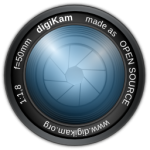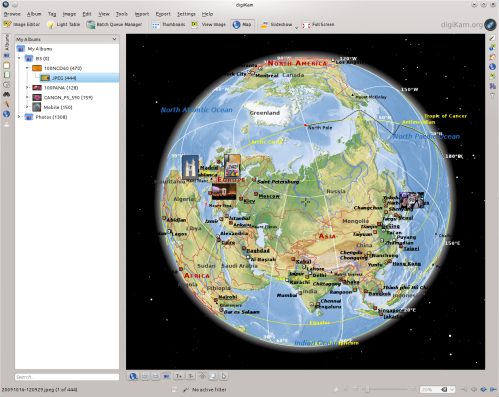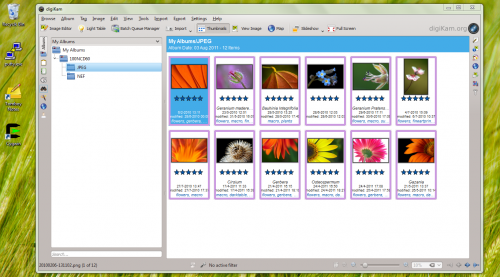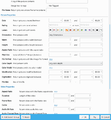Digikam: Difference between revisions
(New page: {| |thumb|250px|left| ||An advanced digital photo management application, capable of working directly with many makes of camera and many file types. |} ::* Th...) |
(Converted dko link to new standard) |
||
| (48 intermediate revisions by 7 users not shown) | |||
| Line 1: | Line 1: | ||
{| | <languages /> | ||
|[[Image: | <translate> | ||
<!--T:1--> | |||
{|class=tablecenter | |||
|[[Image:logo-digikam.png|thumb|150px|left|]] ||'''View, manage, edit, enhance, organize, tag, and share photographs.''' | |||
|} | |} | ||
<!--T:2--> | |||
DigiKam supports import of photos from cameras, creation of albums, tagging with dates, subjects and other properties, and excellent search facilities. Please consult the manual for full details, including picture formats supported. | |||
<!--T:3--> | |||
__TOC__ | |||
==Managing your Photos== <!--T:4--> | |||
<gallery perrow="4"> | |||
Image:Digikam_album.png|Album View | |||
Image:Digikam_timeline.jpg|Timeline View | |||
Image:Digikam_exif.png|View Exif information | |||
Image:Digikam_geolocation.png|Geolocation | |||
Image:Digikam_search.png|Search View | |||
Image:Digikam_search-details.png|Detailed Search | |||
Image:Digikam_find-dupes.png|Identify duplicates | |||
Image:Digikam_fuzzy-search.jpg|Fuzzy Search | |||
</gallery> | |||
==The Image Editor== <!--T:5--> | |||
<gallery perrow="4"> | |||
Image:Digikam_tagging.png|Tagging | |||
Image:Digikam_rating.png|Assigning a Rating | |||
Image:Digikam_adjust_levels.png|Adjust Colour Levels | |||
Image:Digikam_white_balance.png|White Balance Adjustment | |||
Image:Digikam_b_w.png|Convert to Black and White | |||
Image:Digikam_redeye.png|Red-eye correction | |||
Image:Digikam_colorCorrection.png|Auto Colour Correction | |||
Image:digikam_lens_correct.png|Lens Auto Correction | |||
</gallery> | |||
==The Camera Interface== <!--T:6--> | |||
<gallery perrow="4"> | |||
Image:Digikam_card_media.png|Read from Removable Media | |||
Image:Digikam_camera.png|or from Camera | |||
Image:Digikam_album-save.png|Save direct to Albums | |||
Image:Digikam_geolocation2.png|Add Geolocation to Individual Photos | |||
</gallery> | |||
==The Light Table== <!--T:7--> | |||
<gallery perrow="4"> | |||
Image:Digikam_compare-range.png|Compare from a range of photos | |||
Image:Digikam_examine-details.png|Examine Details | |||
Image:Digikam_rate-range.png|Rating makes choice easier | |||
Image:Digikam_lt-settings.png|See the camera settings | |||
</gallery> | |||
==ShowFoto== <!--T:8--> | |||
For those who find the DigiKam interface a tad too technical, ShowFoto gives access to the same tools, with a popular interface. | |||
<!--T:9--> | |||
<gallery perrow="4"> | |||
Image:Showfoto_browse.png|Browsing | |||
Image:Showfoto_properties.png|Image Properties | |||
Image:ShowFoto_select.png|See image properties | |||
Image:ShowFoto_geolocation.png|Geolocation again | |||
Image:ShowFoto_zoom.png|Preset zooms | |||
Image:ShowFoto_histogram.png|Histogram | |||
Image:ShowFoto_general.png|General Settings | |||
Image:ShowFoto_tooltips.png|Tooltip Options | |||
Image:ShowFoto_raw-image.png|Raw Image Settings | |||
Image:ShowFoto_color-management.png|Colour Management Settings | |||
Image:ShowFoto_save.png|File Saving Options | |||
Image:ShowFoto_slideshow.png|Configure a Slideshow | |||
</gallery> | |||
<!--T:10--> | |||
::* The project Home Page is [http://www.digikam.org/ here] | ::* The project Home Page is [http://www.digikam.org/ here] | ||
::* A detailed User Manual is [http://docs.kde.org/ | ::* A detailed User Manual is [http://docs.kde.org/?language=en&application=digikam here]. You will find these and many other screenshots there. | ||
<!--T:11--> | |||
[http://www.digikam.org/drupal/support The support page] of the project has | |||
links to [http://www.digikam.org/?q=faq/digikam Frequently Asked Questions] (FAQs) and to [http://www.digikam.org/?q=support#mailinglists Mailing List] | |||
subscription details. | |||
<!--T:12--> | |||
There is a short video tour [http://www.digikam.org/drupal/tour here]. | |||
<!--T:13--> | |||
The section on '''Digital Asset Management''' is no longer on the web pages, but in the manual, which may be present on your installation as digikam-doc, or you can download a set of .pdf files, [http://docs.kde.org/development/en/extragear-graphics/digikam/digikam.pdf digikam.pdf], [http://docs.kde.org/development/en/extragear-graphics/showfoto/showfoto.pdf showfoto.pdf] and [http://docs.kde.org/development/en/extragear-graphics/kipi-plugins/kipi-plugins.pdf kipi-plugins.pdf] | |||
<!--T:14--> | |||
The blog [[Special:myLanguage/Digikam/Tour|Open Source Photo Processing Comes of Age]] by rm42 highlights developments since the KDE 3 version, and provides a useful tour. | |||
<!--T:20--> | |||
We have a growing collection of tutorials that will help you get more enjoyment and productivity from '''digikam'''. [[Special:myLanguage/Digikam/Tutorials|The Digikam tutorials page]] lists them with a brief comment on content. | |||
<!--T:15--> | |||
{{Tip|1=Click on the <menuchoice>Photography</menuchoice> category at the bottom of this page to see a list of all available tutorials for Digikam and Showfoto.}} | |||
== Useful digiKam Tricks == <!--T:21--> | |||
Transcribed from Dmitri Popov's blog, 26 September 2011 | |||
<!--T:22--> | |||
# To quickly adjust thumbnail size in the Album view, press and hold the <keycap>Ctrl</keycap> key, then use the mouse scroll wheel to make the thumbnails larger or smaller.</translate> | |||
<translate> | |||
<!--T:24--> | |||
# With the <menuchoice>Non-Destructive editing and Versioning</menuchoice> feature enabled, '''digiKam''' automatically hides originals and displays the latest modified versions of the photos. For example, if you process a NEF file and save it in the JPEG format, '''digiKam''' hides the original RAW file and shows only the JPEG photo. To disable this feature, choose <menuchoice>Settings -> Configure digiKam -> Editing Images</menuchoice> and make sure that the <menuchoice>Always show original images</menuchoice> option in the '''In main view''' section is enabled. To keep things tidy, you can then group the original and all its versions. To do this, select the photos you want to group, right-click on the selection, and choose <menuchoice>Group -> Group Selected Here</menuchoice>.</translate> | |||
<translate> | |||
<!--T:25--> | |||
# {{Output|1=The trash has reached its maximum size! Cleanup the trash manually}} If you receive this error message and emptying the Trash doesn’t help, then the following command may solve the problem: {{Input|1=rm ~/.local/share/Trash/metadata}}</translate> | |||
<translate> | |||
<!--T:26--> | |||
# Need to quickly locate all untagged photos? In '''digiKam''', expand the <menuchoice>Search</menuchoice> left sidebar, and press the <menuchoice>Advanced Search</menuchoice> button. In the <menuchoice>Advanced Search</menuchoice> window, tick the <menuchoice>Not Tagged</menuchoice> check box and press <menuchoice>OK</menuchoice> to run the search.</translate> | |||
<translate> | |||
<!--T:27--> | |||
# Instead of the conventional thumbnail view, '''digiKam''' lets you map your photos on a globe. Choose <menuchoice>View -> Map</menuchoice>, and you should see photos from the current album mapped on the 3-D globe. You can then use the mouse to rotate the globe and the mouse wheel to zoom in and out. Obviously, the Map view displays only geotagged photos. | |||
<!--T:23--> | |||
[[Image:Digikam_mapview.png|center|500px|thumb|Copyright D.Popov]] | |||
== digiKam 2.2.0 Installer for Windows == <!--T:28--> | |||
In his blog of 22 October, 2011, Dmitri Popov writes: | |||
<!--T:29--> | |||
"Good news for those who want to run the latest version of '''digiKam''' on '''Windows'''. The SourceForge repository now has a Windows installer of the latest '''digiKam''' version courtesy of Ananta Palani. | |||
<!--T:30--> | |||
[[Image:Digikam_wininstaller.png||center||500px]] | |||
<!--T:31--> | |||
I tested the installer with a Windows 7 machine, it worked like a charm. While the installer makes it supremely easy to deploy '''digiKam''' on '''Windows''', the application does have a few quirks. Most notably, the '''Windows''' version of '''digiKam''' cannot import photos directly from storage media or cameras, so you need to copy them to the hard disk using '''Windows’''' own built-in image transfer tool, and then add the transferred photos to '''digiKam'''. The ''Trash'' feature doesn’t work either, but you can work around this issue by deleting photos instead of sending them to the trash. To be fair, though, these issues are not caused by '''digiKam''' itself, but are due to bugs in the underlying KDE libraries which the application relies on." | |||
<!--T:16--> | |||
[[Category:Graphics]] | |||
[[Category:Photography]] | |||
</translate> | |||
Revision as of 15:33, 6 November 2014
 |
View, manage, edit, enhance, organize, tag, and share photographs. |
DigiKam supports import of photos from cameras, creation of albums, tagging with dates, subjects and other properties, and excellent search facilities. Please consult the manual for full details, including picture formats supported.
Managing your Photos
-
Album View
-
Timeline View
-
View Exif information
-
Geolocation
-
Search View
-
Detailed Search
-
Identify duplicates
-
Fuzzy Search
The Image Editor
-
Tagging
-
Assigning a Rating
-
Adjust Colour Levels
-
White Balance Adjustment
-
Convert to Black and White
-
Red-eye correction
-
Auto Colour Correction
-
Lens Auto Correction
The Camera Interface
-
Read from Removable Media
-
or from Camera
-
Save direct to Albums
-
Add Geolocation to Individual Photos
The Light Table
-
Compare from a range of photos
-
Examine Details
-
Rating makes choice easier
-
See the camera settings
ShowFoto
For those who find the DigiKam interface a tad too technical, ShowFoto gives access to the same tools, with a popular interface.
-
Browsing
-
Image Properties
-
See image properties
-
Geolocation again
-
Preset zooms
-
Histogram
-
General Settings
-
Tooltip Options
-
Raw Image Settings
-
Colour Management Settings
-
File Saving Options
-
Configure a Slideshow
The support page of the project has links to Frequently Asked Questions (FAQs) and to Mailing List subscription details.
There is a short video tour here.
The section on Digital Asset Management is no longer on the web pages, but in the manual, which may be present on your installation as digikam-doc, or you can download a set of .pdf files, digikam.pdf, showfoto.pdf and kipi-plugins.pdf
The blog Open Source Photo Processing Comes of Age by rm42 highlights developments since the KDE 3 version, and provides a useful tour.
We have a growing collection of tutorials that will help you get more enjoyment and productivity from digikam. The Digikam tutorials page lists them with a brief comment on content.
Useful digiKam Tricks
Transcribed from Dmitri Popov's blog, 26 September 2011
- To quickly adjust thumbnail size in the Album view, press and hold the Ctrl key, then use the mouse scroll wheel to make the thumbnails larger or smaller.
- With the feature enabled, digiKam automatically hides originals and displays the latest modified versions of the photos. For example, if you process a NEF file and save it in the JPEG format, digiKam hides the original RAW file and shows only the JPEG photo. To disable this feature, choose and make sure that the option in the In main view section is enabled. To keep things tidy, you can then group the original and all its versions. To do this, select the photos you want to group, right-click on the selection, and choose .
The trash has reached its maximum size! Cleanup the trash manually
If you receive this error message and emptying the Trash doesn’t help, then the following command may solve the problem:rm ~/.local/share/Trash/metadata
- Need to quickly locate all untagged photos? In digiKam, expand the left sidebar, and press the button. In the window, tick the check box and press to run the search.
- Instead of the conventional thumbnail view, digiKam lets you map your photos on a globe. Choose , and you should see photos from the current album mapped on the 3-D globe. You can then use the mouse to rotate the globe and the mouse wheel to zoom in and out. Obviously, the Map view displays only geotagged photos.

digiKam 2.2.0 Installer for Windows
In his blog of 22 October, 2011, Dmitri Popov writes:
"Good news for those who want to run the latest version of digiKam on Windows. The SourceForge repository now has a Windows installer of the latest digiKam version courtesy of Ananta Palani.

I tested the installer with a Windows 7 machine, it worked like a charm. While the installer makes it supremely easy to deploy digiKam on Windows, the application does have a few quirks. Most notably, the Windows version of digiKam cannot import photos directly from storage media or cameras, so you need to copy them to the hard disk using Windows’ own built-in image transfer tool, and then add the transferred photos to digiKam. The Trash feature doesn’t work either, but you can work around this issue by deleting photos instead of sending them to the trash. To be fair, though, these issues are not caused by digiKam itself, but are due to bugs in the underlying KDE libraries which the application relies on."





































